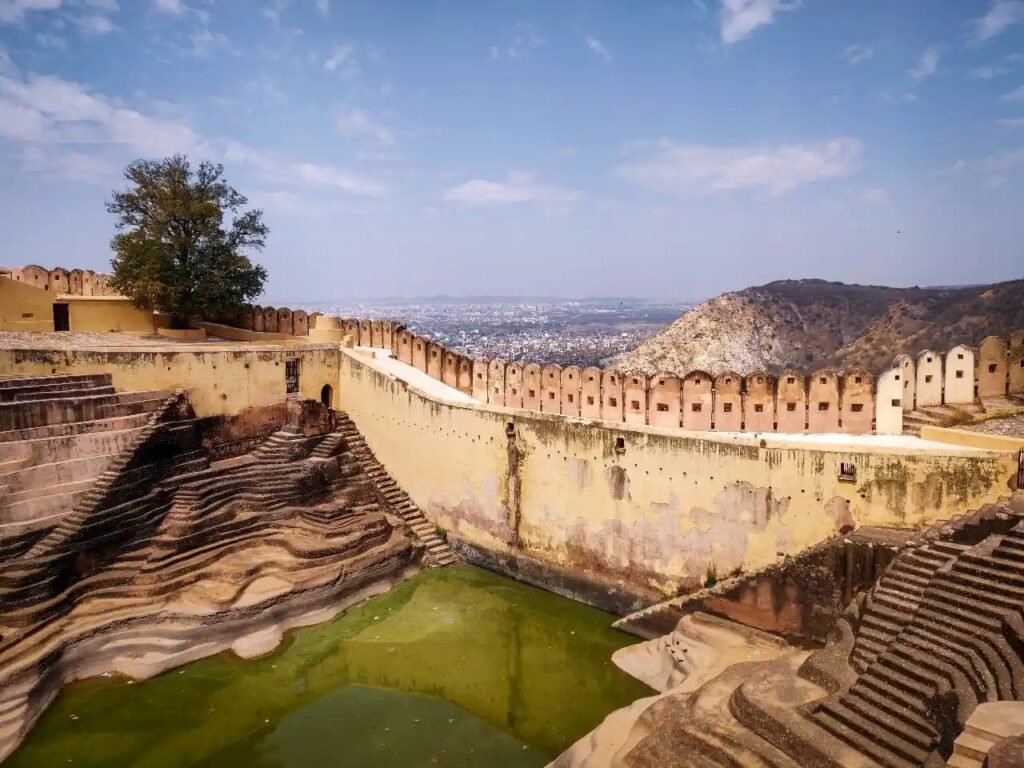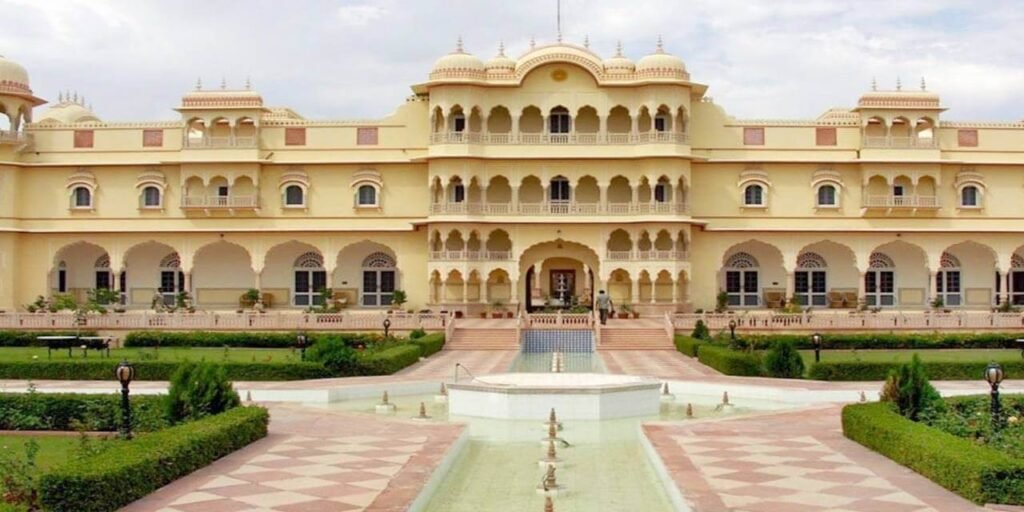Nahargarh Fort, perched regally atop the Aravalli Hills, is among Jaipur’s most captivating destinations for visitors seeking an enchanting blend of history, architecture, and panoramic vistas. Its storied past, intriguing legends, and remarkable construction have made it a cherished cultural treasure in Rajasthan.
History of Nahargarh Fort
Nahargarh Fort was built in 1734 by Maharaja Sawai Jai Singh II, the founder of the city of Jaipur. Originally called Sudershangarh, it soon acquired its popular name “Nahargarh,” which means “abode of tigers,” with folklore attributing the moniker to the restless spirit of a Rathore prince, Nahar Singh Bhomia. To appease this spirit, a temple was erected inside the fort, and the name stuck.
Designed as a retreat and a defensive outpost to protect Jaipur, Nahargarh never endured a direct attack, but it played a crucial strategic and diplomatic role, notably in truce negotiations with Maratha forces in the 18th century. During the 1857 Indian Mutiny, the fort sheltered Europeans, including the British Resident’s wife, under the protection of the Jaipur king.
Extensions during the 19th century, particularly under Maharaja Sawai Ram Singh and later Sawai Madho Singh, introduced new palaces, barracks, water tanks, and the famed Madhavendra Bhawan, a magnificent palace for the king and his queens.
Key Details:
Nahargarh Fort Architecture and Culture
The fort radiates an unmistakable Indo-European architectural style. Its entrance, known as Tadigate, leads into a complex of temples, palaces, courtyards, stepwells, and corridors. The main Madhavendra Bhawan is a two-storied palace featuring nine suites for the queens, all linked by secret corridors, and a lavish suite for the king.
Decorative frescoes, intricate motifs, and the artful blend of Rajput and European architecture stand as a testament to the rich culture and royal lifestyle of the Jaipur Maharajas. The fort also contains the Diwan-i-Aam (public hall), two asymmetrical stepwells designed to preserve water without disturbing the rugged mountain terrain, and temples dedicated to Nahar Singh Bhomia and the royal family.
Nahargarh as a Tourist Destination
Nahargarh Fort is a top tourist attraction in Jaipur, renowned for its breathtaking views of the “Pink City,” surrounding hills, and unforgettable sunsets. The site now features a wax museum, sculpture park, fine-dining restaurant, cafes, and vibrant nighttime tourism ventures, making it an essential destination for travellers of all ages.
Visitors are mesmerised by the panoramic scenery, historic ambience, and architectural splendour, with the terraces and stepwells being especially photogenic spots. The fort is open daily from 10:00 AM to around 5:00 PM, with unique experiences available during evening hours, including illuminated frescoes.
Tourism Revenue and Popularity
Nahargarh Fort is a significant contributor to Jaipur’s tourism industry, attracting thousands of domestic and international tourists each year. For instance, on busy days, such as New Year’s Eve, over 6,000 tourists visit the monument in a single day, boosting its revenue and significance. The fort’s allure, alongside improved infrastructure and curated attractions, has solidified its status as one of Rajasthan’s most-visited historic sites.

Location and Accessibility
Nahargarh Fort is strategically situated about 6 kilometres from Jaipur city centre, making it easily accessible from various parts of the city. Its commanding position atop the Aravalli hills, at a height of 700 feet, ensures visitors enjoy spectacular vistas.
How To Reach Nahargarh Fort
- By Car or Taxi: The most comfortable way, with several routes leading up the hill.
- By Two-Wheeler: Take Nahargarh Road via Chandpole Bazar for a shorter, winding ascent—ideal for bikes.
- By Four-Wheeler: The Amer Road route is preferred for cars and offers scenic views.
- By Bus: Multiple bus routes connect Jaipur station and city landmarks to Nahargarh, though the trip may take over an hour.
- By Foot: Adventurous trekkers can reach the top in approximately 90 minutes from the city, enjoying the natural scenery en route.
Entry Fees and Timings
- Indian Nationals: ₹50
- Foreign Tourists: ₹200
- Indian Students: ₹5
- Foreign Students: ₹25
- Timings: 10:00 AM – 5:00 PM (some attractions open later for night tourism).
Cultural Significance
Nahargarh Fort’s importance extends beyond military and architectural achievements; it is a symbol of Jaipur’s royal heritage and cultural vigour. The site has hosted significant events, served as a royal retreat, and functioned as the city’s official timekeeper, with a daily gunshot signalling the hour until 1944.
The fort’s popularity as a filming location, including movies like “Rang De Basanti” and “Shuddh Desi Romance”, continues to reinforce its modern cultural impact.
FAQs About Nahargarh Fort
What is the history behind Nahargarh Fort?
Nahargarh Fort was constructed by Maharaja Sawai Jai Singh II in 1734 as a defensive retreat and royal residence. It was never attacked, but played key diplomatic and protective roles throughout its history.
Why is it called Nahargarh?
The name means “abode of tigers” and refers to both the fort’s imposing location and the legend of being haunted by Prince Nahar Singh Bhomia, whose spirit was appeased by building a temple in his name.
What are the top attractions within Nahargarh Fort?
- Madhavendra Bhawan: The royal palace with 9 suites for queens.
- Stepwells: Asymmetric, scenic reservoir structures.
- Panoramic Viewpoints: Sweeping vistas of Jaipur city.
- Wax Museum & Sculpture Park: Modern attractions for tourists.
How can tourists reach Nahargarh Fort?
Visitors can reach by car, taxi, two-wheeler, or public bus. The routes vary by vehicle, with especially scenic drives via the Amer Road.
What is the entry fee and best time to visit?
Entry for Indian adults is ₹50, and for foreigners, it is ₹200; discounted rates are available for students. The fort is popular throughout the day, but evening visits, especially for sunset views and illuminated palaces, are highly recommended.
What is the cultural significance of the fort?
Nahargarh embodies Jaipur’s rich royal heritage, blending Rajput military ingenuity with periods of art, culture, and diplomacy. It has become a venue for public events, artistic exhibitions, and film shoots, symbolising the ever-evolving cultural tapestry of Rajasthan.
How does Nahargarh Fort contribute to tourism revenue?
With new attractions, improved facilities, and nighttime experiences, foot traffic and revenues have sharply increased, regularly drawing thousands of tourists during peak periods and contributing substantially to local tourism.
Route Details and Accessibility Guide
Nahargarh Fort’s accessibility is facilitated by excellent road connectivity and proximity to the heart of Jaipur.
Directions
- From Jaipur City Centre: 6 km via Delhi Road or Amer Road; a cab or an auto is the fastest.
- From Jaipur Railway Station: About 8.4 km; options include bus, taxi, or foot.
- Nearby Attractions: Jaipur’s famous Amer and Jaigarh forts are part of the defensive ring and can be visited together for a complete historical experience.
Revenue and Impact
Night tourism, new museums, and cultural events have given Nahargarh Fort’s revenue a boost. At times, it has reported single-day tourist numbers crossing 6,000 with proportional increases in revenue; during festive or holiday periods, the figure is even higher. Continuous upgrades and visitor-friendly initiatives ensure that Nahargarh remains a profitable pillar of Rajasthan’s tourism sector.
The Complete Visitor Experience
Visiting Nahargarh Fort means stepping into centuries of royal legacy, exploring palatial quarters, marvelling at intricate artwork, and capturing the drama of Jaipur’s skyline, from sunrise to sunset. It is an unmissable cultural immersion for history buffs, photographers, and seekers of Rajasthan’s living heritage.
